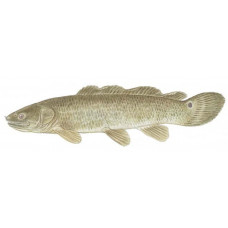Latin name
Amia calva
Other names
Dogfish, freshwater dogfish, blackfish, mudfish, western mudfish, mud pike, cabbage pike, shoepike, griddle, grindle, spottail grindle, grinnel, lawyer, scaled ling, speckled cat, cypress trout, cypress bass, cottonfish, John A. Grindle; French: choupiquel, poisson de marais.
Identification
The ancient fish, described by some as looking more like a snake than a fish, has a rounded tail and a significant amount of cartilage in its skeletal system. There is a large bony plate under the head, and several other bony plates protect the skull. Distinctive features are the large flattened head with tube-shaped nostrils and long sharp teeth, and the long tailless dorsal fin, which extends almost the entire length of the body. Another interesting feature of bowfin anatomy is the presence of a modified air bladder, similar to the lungs, in addition to the gills. Like a gar possessing a similar organ, the bowfin is capable to breathe surface air and therefore live in water too polluted or stagnant for most fish. Its long, thick, cylindrical body is covered with large olive-colored scales, although it sometimes has a brownish or gray patina that turns white or cream underneath. The male has a dark spot on the upper part of the tail with a yellowish-orange rim around it, while the female has a less noticeable spot without the rim.
Distribution
Bowfin is found only in North America, from the St. Lawrence River and Lake Champlain in Quebec and Vermont west through southern Ontario to the Mississippi River, from Minnesota south to Texas and Florida.
Habitat
Bowfin as a rule to be large-bodied fish and live in warm and marshy lakes with vegetation, as well as in weedy rivers and streams. With considerable resistance to high temperatures and a modified air bladder, the bowfin capable to live in stagnant areas by drawing in surface air.
Size
A bowfin can grow up to 43 inches in length, but averages up to 2 feet. The world record bowfin weighed 21 pounds 8 ounces, although the average weight is in the 2 to 5 pound range. Males are smaller than females, and they live up to 12 years in the wild and up to 30 years in captivity.
Life history and Behavior
At the age of 3 to 5 years, they reach sexual maturity. They spawn from early April through June, when water temperatures range from 60° to 66 °F. Males emerge into weedy shallow waters after dark, before females, and build bowl-shaped nests of plant material among tree roots or under fallen logs. One male may attempt to mate with several females, and, sometimes, several pairs use the same nest. The male stays to guard the eggs, which hatch after 8–10 days. The newly hatched bowfin use sticky organs on their snouts to attach themselves to the bottom of the nest when they grow to about 1⁄2 inch in length. Once they reach this length, the fry become schoolers and follow the male, who guards them from possible predators for somewhat weeks. Adult coloration appears when they are about 11⁄2 inch long, and juveniles begin to protect themselves at this stage. They stop training completely when they reach a length of 4 inches. The fish swim slowly along the bottom, although they can move very fast if disturbed or when in pursuit of prey.
Food and feeding habits
Bowfin can be extremely voracious and eat a wide variety of foods, including crayfish, shrimp, adult insects and larvae, small fish, frogs, and large amounts of vegetation. Smell is as important to extraction as sight, and fish have a habit of gulping down water to catch their prey. Although they are always ready to feed, they are most active in the evening.
Reproduction
Bowfin build unique nests from aquatic plants that resemble deep bowls. They place them exclusively in shallow waters.
Interesting facts
In the Bowfin, the swim bladder has been transformed into a specialized breathing organ. Air enters this swim bladder, which replaces the lungs, through the mouth or nasal openings. This is possible because this organ is highly vascularized, meaning it is lined with blood vessels that allow it to act like a lung.
| Classification | |
| Phylum | Chordata |
| Class | Actinopterygii |
| Squad | Amiiformes |
| Family | Amiidae |
| Genus | Amia |
| Species | A. calva |
| Features | |
| Conservation status | Least Concern |
| Habitat | Bottom |
| Life span, years | 33 |
| Maximum body weight, kg | 9.75 |
| Maximum length, cm | 109 |
| Sailing speed, m/s | No information |
| Threat to people | Edible |
| Way of eating | Predator |
Bowfin
Tags: Bowfin




